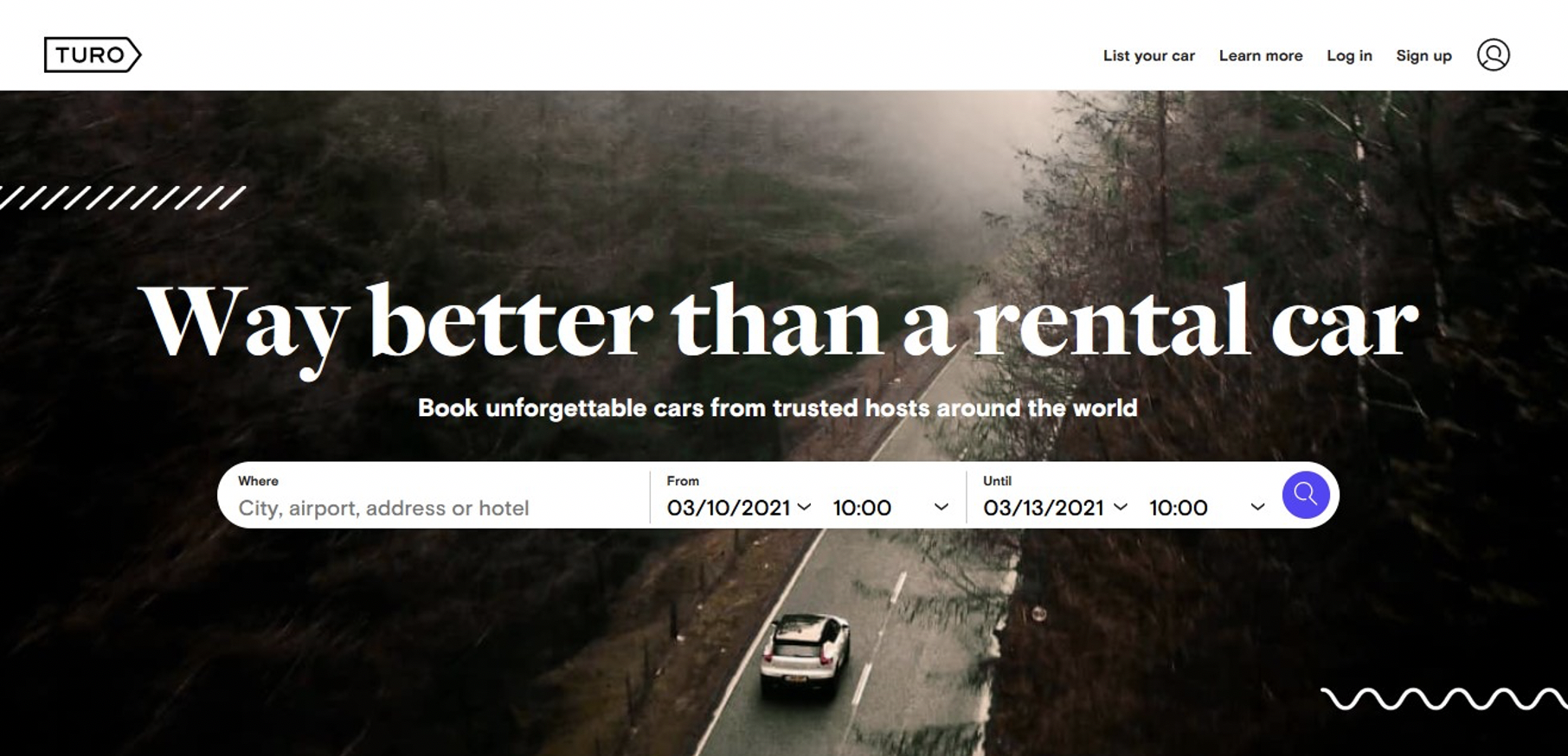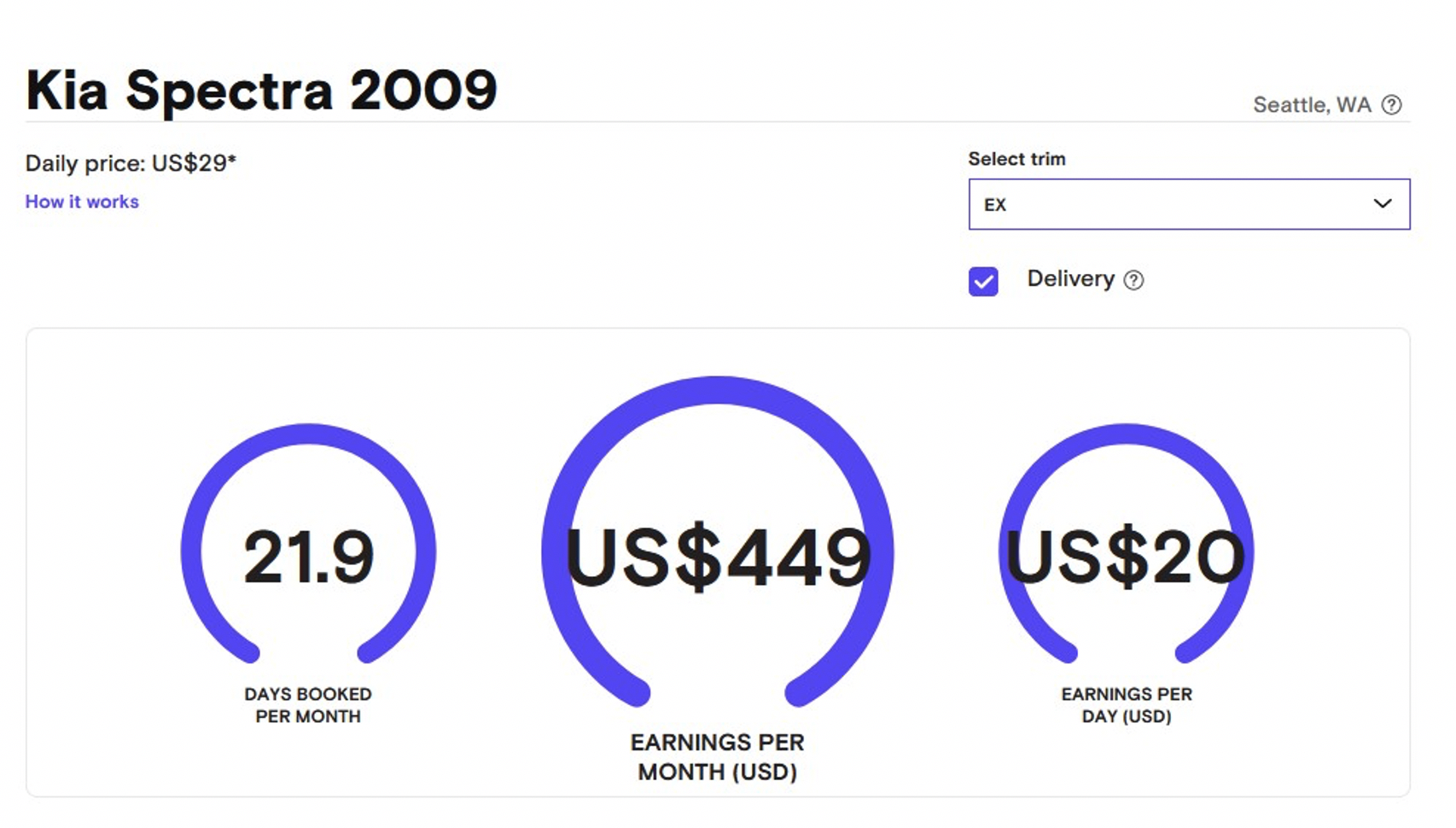This post is about how to make money on Turo!
If you’re looking for a get-rich-quick scheme, this post isn’t it. However, if you’re looking for an extra source of income that could earn you up to $700 per month, then this might just be the thing you’re looking for!
What I’m talking about is Turo. Turo is, for all intents and purposes, the Airbnb of the auto world. It connects people looking for a rental vehicle to hosts with a rental vehicle to offer, similarly to the way that Airbnb connects guests with places to stay.
Renting out your vehicle on Turo is a great idea but isn’t the right move for everyone looking to make cash. There are a ton of factors to consider when getting into the car rental business. This includes the profit that Turo takes from your business and the eligibility of your vehicle.
Regardless, if you’re interested in getting to know Turo a bit better, keep reading! We’re going to go in-depth on the topic. Sign up for Turo here.
How to Make Money on Turo

If you haven’t checked out Turo yet, it is the world’s largest peer-to-peer car sharing marketplace. It allows you to book any car you want from a community of hosts across the US, Canada, and the UK.
Turo FAQ
How much can I make using Turo?
According to Turo’s creators, vehicle owners make an average of $700 per month in passive income.
How much of my earnings does Turo take?
Turo takes 15-40% of your rental cost. This cut covers your vehicle insurance and advertising on their main site, which is what helps you get renters.
How long does it take to get started using Turo?
Turo is easy to set up. Generally, you can register and list your vehicle within 10 minutes. Depending on where you live, you may be able to book renters right away.
How do I know if my car is eligible for use with Turo?
For your vehicle to be eligible for renting out on Turo, is needs to have been released within the last 12 years. It should have fewer than 13,000 miles, the value cannot exceed $150,000. If you’re leasing the vehicle you want to rent, you can do so as long as it doesn’t violate the terms of your lease agreement. Large vans, off-road vehicles, and motorcycles are not eligible.
What happens if renters damage my vehicle?
If a renter damages your vehicle, they’re held liable for it. Turo will work out the problem for you.
Is there a limit to how much I can charge for extras?
No. Turo lets you set your own limits.
Is Turo safe to use?
Yep! You can feel safe using Turo. They take the trust of their clients very seriously and are excellent to work with.
What winter safety requirements does Turo have for vehicles?
In areas where winters consist of snow and ice, clients are required to provide chains and winter tires. In Canada specifically, clients are legally required to follow the guidelines of their province in order to rent out their vehicle during the winter.
Who pays for fuel?
When someone rents your vehicle, they are responsible for fueling it. In fact, they must return the vehicle to you with the same amount of fuel in it as there was when they got it. This works the same way for electric vehicles.
Getting Started
Using the Turo Car Calculator
If you’ve read this far, chances are that you’re still interested. You’re probably wondering whether you will actually be able to make money on the platform – or, rather, whether you can make enough to consider the venture worthwhile. Not all side hustles are profitable, after all.
Luckily, there’s a handy tool provided by Turo to help you assess this. The Turo Car Calculator can help you estimate your earnings. All you have to do is plug in your car’s details and your location to receive an estimate of the vehicle’s value as a rental.

The photo above is an example of what a 2009 Kia Spectra with the EX trim would bring in in terms of income per month.
Keep in mind, though, that the calculator won’t give you exact figures and that your actual earnings will depend on factors such as:
- Daily rate
- The chosen Turo insurance option
- How many days per month your vehicle is available
- Whether you choose to charge renters for extras
Listing Your Vehicle on Turo
To get started, you’ll need to sign up using your email, Google, Facebook, or Apple ID. Once you’ve created your account, you can navigate to the ‘List Your Car’ button on the top right-hand side of the screen.
The site will then prompt you to enter your vehicle’s information. Be prepared to give your license plate number, the make and model of your vehicle, photos of the vehicle, and whether or not your vehicle uses an automatic transmission.
The next step is deciding on rental rate. Turo will likely suggest a rate for you based on your vehicle information and location, however, you can manually enter your desired rate if you want. Since the platform only charges per day with the options of booking for a week or a month with discounts, renters are required to pay a full day’s rate. They cannot just pay for one or two hours.
Then, you’ll be asked to choose an insurance plan. The company offers five options for users and depending on which you opt to go with, you will take home 60-85% of your rental fees.
You also get to choose how your vehicle gets to its renter on rental day. You can charge a delivery fee if you’re willing to meet the customer at the airport, a bus station, or another location. You could also park the car in a lot and request that the customer picks it up on their own.
Regardless, this information needs to be communicated in your listing so that customers know what to expect when booking your vehicle. Should you wish to, you can change the delivery fee.
In addition to choosing your rental rates, you can also choose how much milage you want customers to be able to put on your vehicle. This can be done by setting limits, after which the customer will have to pay a fee per every additional mile. The nice thing about this fee (for you) is that you get to keep every cent of it.
Lastly, choose your availability. Your vehicle doesn’t have to be available for rent every day. You can set it so it’s only available on certain days, allowing you to tailor the availability to your schedule. You can also set it as unavailable for upcoming dates.
When it comes to being paid for your vehicle rental, clients in the US can receive payment via a direct bank transfer. Anyone in the UK or Canada, however, has to be paid through PayPal.
Tips for Earning More on Turo
Post a detailed listing.
When listing your vehicle on the website or app, try to see it from the point of view of a potential renter. This means including everything that a renter might be interested in knowing.
You can include measurements and capacity of the trunk, if the vehicle has ever been smoked in, whether the vehicle has a bike rack or tow hook, if it has heated seats or an awesome set of speakers and much more. You might also include the technologies that the vehicle has such as a satellite radio, Bluetooth connectivity, built-in GPS, and a back-up camera.
Basically, everything that would draw you to a vehicle is probably good to include.
Set reasonable prices.
Be sure to check out the prices set by others in your area. For example, if someone is offering a midsize sedan for $50 per day, why not offer your midsize sedan for $40? Customers (and people in general!) like to get great deals and providing the cheapest rates is a great way to get your rental business going.
Take great photos.
Photos are what people will notice first about your listing. If you have photos that are blurry, too far away, or too dark or light your listing isn’t going to get as many views as it would with professional photos that are pleasing to the eye.
Professional photos don’t have to be taken by a professional, but they can be if you’re willing to pay a fee (a feature that Turo offers to connect clients with paid professional photographers). You can do them yourself by taking a bit of extra care to ensure that the photos you post look good. Make sure the lighting is good, double check that your finger isn’t in the camera, and retake the photo if it looks blurry or out of focus.
You could go one step further, too, and stage your photos by removing things from the background (paint cans or tools if you’re taking photos in your garage) to bring attention to your vehicle.
If your photo is perfect aside from a slightly darker than necessary tone, use a free editing app to bring up the brightness – just make sure that you don’t overdo it. You’re not trying to mask what the car looks like, only enhance its natural beauty.
Promote, promote, promote.
What’s the best way to get new clients? Promotion, of course! Every successful campaign every ran has used some sort of promotion or advertising – and rental campaigns are no exception.
To be successful, you need to have an understanding of the importance of good promotion. You might be thinking that you can’t do promotion because you don’t have access to a video camera or a space in which you can plaster a promotional poster, but don’t worry! You can promote your rental vehicle without those things.
Promotion can be as simple as sharing your listings on your social media. By enabling your listings to be shared, they can reach new clients that are outside of your friend circle.
You could also post your listings on sites such as Kijiji or Craigslist. They are even a few websites that allow vendors (you) to post their listings for free or for a small, affordable fee.
Additional Information About Turo
The Beginning of Turo
Turo was founded in San Francisco in 2009. Initially, the idea was to create a company that would change the way that your everyday person rented vehicles. Instead of having renters pay hefty fees and receive lack-luster customer service, Turo was determined to provide an affordable rental service with personalized service.
Turo was designed to include a variety of customers, from pickup truck owners to sports car enthusiasts. Today, Turo caters to clients and their renters who live in the UK, Canada, and the US.

Turo’s Customer Service
Turo’s goal of excellent customer service has been reached. Today, the customer service team keeps an eye on the entire rental process to ensure that everything goes smoothly.
When a renter accepts a rental vehicle, they’re asked to take photos of the vehicle to showcase its condition. This is done to mitigate any confusion about the state of the vehicle in case there are any concerns regarding the vehicle’s condition later on.
Renters are expected to treat their rental vehicles with care – but people are only human and, unfortunately, they don’t always return vehicles in top-notch conditions. If this happens, the customer service team will step in and handle everything for you.
Since the renters have already sent photos of the vehicle’s initial condition, if you’re unhappy with the returned condition all you have to do is sed your own photos. If the vehicle requires professional attention – whether it be cleaning or repairs – Turo will reimburse you for the cost. For renters who leave vehicles in poor condition, drain the battery, or otherwise damage the vehicle, the consequences are serious. They are held responsible for everything they do with your vehicle.
Conclusion
We hope you like this breakdown of how to make money on Turo. This could be a great way to make some extra money on your journey to financial freedom! Hope you like this post and let us know what you think in the comments below.


Comments 1
Great and smart way to make money. Thanks for sharing